No.7 Measurement of frequency response function using sine sweep signals output from external system - part 2
Continuing from the previous column, I will introduce the measurement of frequency response function using sine sweep signals output from external system such as a controller of exciter. With this method, the frequency of the sine wave will change regardless of FFT calculation of an analyzer, thus if the sweep speed of sine wave is too fast, the correct results will not be obtained. This time, let me show you a few examples where the power spectrum value of each channel becomes smaller than the original amplitude when the sweep speed is too fast.
●Measuring frequency response function using sine sweep signals output from external system
The figure 1 shows the system configuration example. A sine sweep signal is output from the controller with an oscillator to vibrate the exciter. Attach the accelerometers to the exciter and the measurement target respectively, and the frequency response function (natural frequency) of the measurement target is obtained from these signals.
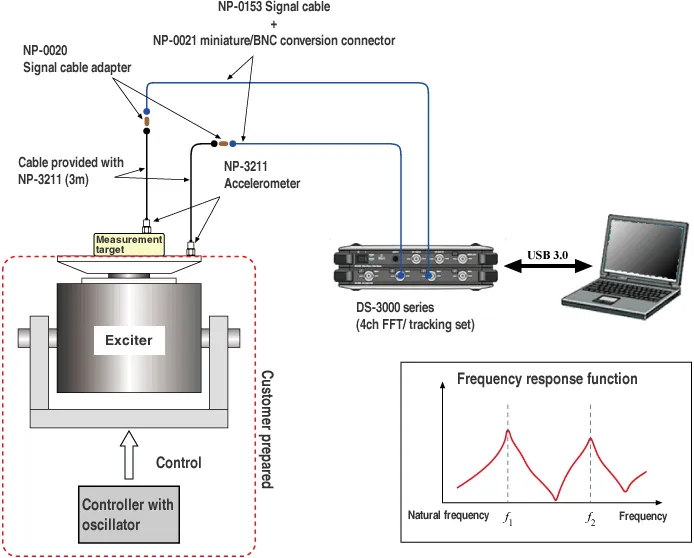
Fig.1 System configuration example
●Standard sweep speedThe relationship between the frequency range, the sampling points, the FFT time length and the ideal sweep speed are as follows and the examples are shown in Table1.
Number of lines= Sampling points ÷ 2.56
Frequency resolution [Hz]= Frequency range [Hz] ÷ Number of lines
FFT time length [sec]= 1 ÷ Frequency resolution [Hz]
Sweep speed [Hz/s]= Frequency resolution [Hz] ÷FFT time length [sec]
= (Frequency resolution [Hz])2
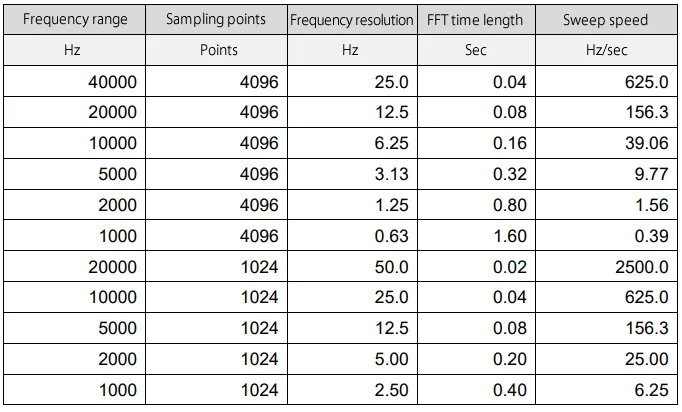
Table 1 Example of frequency range, sampling points, FFT time length and sweep speed
●Measurement example of sine sweep signals from an external system
Figures 2-1, 2-2, and 2-3 show the power spectra when measuring the sine sweep signals from external system. The measurement condition are as follows: the frequency range is 400 Hz, the sampling points is 1024, the frequency resolution is 1 Hz, and the ideal sweep speed is 1 Hz/sec. A function generator outputs the sine sweep signals that have amplitude of 0.1 Vrms and the frequency range from 20 Hz to 200 Hz. The sweep time/ speed are the following three types: 180 sec (1 Hz/sec), 45 sec (4 Hz/sec), and 11.25 sec (16 Hz/sec). Those are 1, 4, and 16 times of the ideal sweep speed obtained from each measurement conditions.
The upper row of each measurement result is the power spectrum when the sine sweep signal is measured. The lower row is the instantaneous spectrum at the frequency of 100 Hz, and the range from 50 Hz to 150 Hz is magnified and displayed.
The amplitude value of the input signal is 0.1 Vrms (-20 dBVrms). While, as the sweep speed increases, the amplitude value of the power spectrum decreases as follows: about -21.6 dBVrms at 1 Hz/sec, about -22.1 dBVrms at 4 Hz/sec and about -26.3 dBVrms at 16 Hz/sec.
As for the instantaneous spectrum, as the sweep speed increases, the peak band of 100 Hz components is wider and the height of peak is lower.
The FFT time length is 1 second under this measurement condition. The time waveform for 1 second is required to obtain the instantaneous spectrum at 100 Hz. As the time waveform includes the frequency components from 92 Hz to 108 Hz at 16 Hz/sec, the band of the instantaneous spectrum obtained from that waveform becomes wider and the peak height (amplitude) becomes lower.
To avoid this phenomenon, it is necessary to decrease the sweep speed of sine wave or increase the ideal sweep speed.
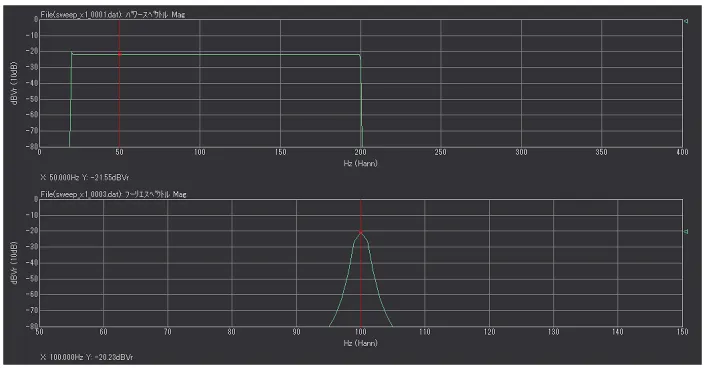
Table2. Overall (OA) calculated from acceleration power spectrum
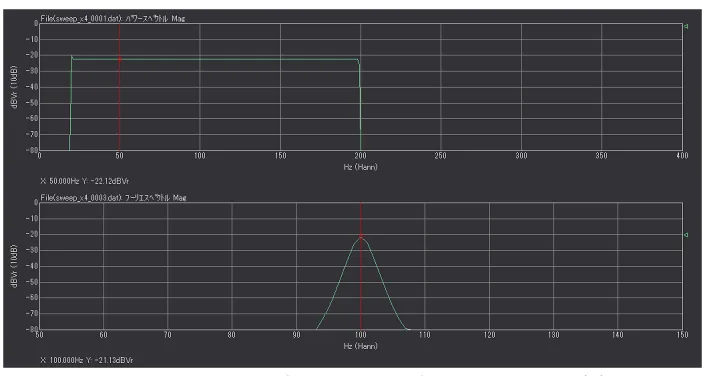
Fig.2-2 Measurement result of sine sweep signal (sweep time: 45 sec, sweep speed: 4 Hz/sec)
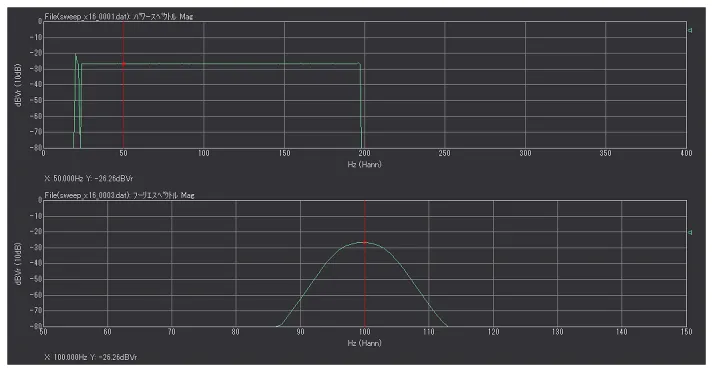
Fig.2-3 Measurement result of sine sweep signal (sweep time: 11.25 sec, sweep speed: 16 Hz/sec)
●Measurement example of sine sweep signals input from external system (log sine sweep)
In the above, I have introduced the measurement results using a “linear sine sweep signal” whose frequency changes at constant intervals. In measuring with a sine sweep signal, a “log sweep signal” that the sweep speed increases as the frequency increases may be used.
The sweep speed of the "log sweep signal" is expressed by how many seconds it takes for the frequency to change by 1 octave. 1 octave mentioned here is the frequency range until the frequency is doubled.
Figures 3 shows the power spectrum when measuring the log sine sweep signals input from external system. The measurement condition are as follows: the frequency range is 400 Hz, the sampling points is 1024, the frequency resolution is 1 Hz. A function generator outputs the log sine sweep signals with amplitude of 0.1 Vrms, the frequency range of 20 Hz to 320 Hz and the seep time for 40 seconds. The sweep speed is 1 Octave/ 10 sec. Sweep from 20 to 320 Hz over 40 seconds as follows: 10 sec between 20 and 40 Hz, 10 sec between 40 and 80 Hz, 10 sec between 80 and 160 Hz, 10 sec between 160 and 320 Hz.
As the frequency increases, the sweep speed increases. The sweep speed per unit time is as follows: 1.4 Hz/sec at 20 Hz, 2.8 Hz/sec at 40 Hz, 5.5 Hz/sec at 80 Hz, 111. Hz/sec at 160 Hz, 22.2 Hz/sec at 320 Hz.
Looking at Figure 3, it found that as higher the frequency is, lower the amplitude of power spectrum is. This is because the frequency is higher, the sweep speed per unit time is faster. In addition, there is missing spectrum around 313 Hz. This is because the FFT operation cannot follow the sweep speed.
Due to the above phenomenon, the log sine sweep signal is not suitable when measuring the frequency response function. If any other signal other than log sine sweep signal is not available, it is necessary to narrow the frequency range to be measure and change the measurement condition to increase the ideal sweep speed, and so on.

Fig.3 Measurement result of sine sweep signal (1 Octave/ 10 sec)
●Summary
This time, I have introduced sine sweep signals; linear sine sweep and log sine sweep. In case of using either signals, if the sweep speed of sine sweep signal is too fast, you cannot measure correctly. You have to decrease the sine sweep speed or change the measurement condition. Further, if you can choose which signals you can use, please use the linear sine sweep signal.
(Y·K)
